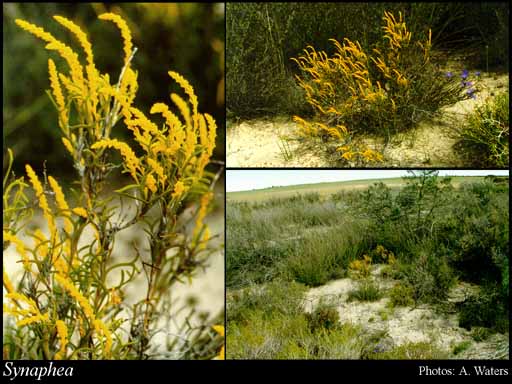- Reference
- Trans.Linn.Soc.London,Bot. p155 (1810)
- Name Status
- Current

Scientific Description
Common name. Synapheas. Family Proteaceae.
Habit and leaf form. Small shrubs; evergreen. Leaves basal, or cauline. To 0.1–1 m high. Mesophytic, or xerophytic. Heterophyllous, or not heterophyllous. Leaves small to large; alternate; usually spiral; leathery; basal leaves long petiolate; sheathing, or non-sheathing; edgewise to the stem, or with ‘normal’ orientation; simple, or compound; epulvinate; pinnate. Leaf blades dissected, or entire; ovate, or obovate, or obtriangular; when dissected, pinnatifid, or dichotomously dissected, or much-divided (often lending the plants a ‘pteridophytic’ aspect). Mature leaf blades adaxially glabrous, or pilose, or pubescent; abaxially glabrous, or pilose, or pubescent. Leaves without stipules. Leaf blade margins entire, or dentate. Leaves without a persistent basal meristem. Leaf anatomy. Hairs present, or absent. Stem anatomy. Secondary thickening developing from a conventional cambial ring.
Reproductive type, pollination. Fertile flowers hermaphrodite. Unisexual flowers absent. Plants hermaphrodite.
Inflorescence and flower features. Flowers aggregated in ‘inflorescences’. Inflorescence many-flowered. Flowers not in pairs subtended by a common bract; in spikes. Inflorescences terminal, or axillary; spike often dense initially but becoming elongate. The fruiting inflorescence not conelike. Flowers sessile; bracteate (bracts small, concave); small; somewhat irregular, or very irregular; zygomorphic (adaxial tepal longest and broadest, hooded; lateral 2 falcate; abaxial smallest, usually with a small, reflexed tip). The floral asymmetry involving the perianth and involving the androecium. Flowers 4 merous; cyclic; tetracyclic. Floral receptacle developing a gynophore, or with neither androphore nor gynophore. Free hypanthium absent. Hypogynous disk absent. Perianth of ‘tepals’; 4; 1 -whorled; joined (basally, tubular, opening in upper third to half); hairy, or glabrous; yellow. Androecial members definite in number. Androecium 4. Androecial members adnate (to tepals); all equal, or markedly unequal; free of one another, or coherent; 1 -whorled. Androecium including staminodes. Staminodes 1; representing the posterior median member. Stamens 3; reduced in number relative to the adjacent perianth. Filaments short and thick. Anthers separate from one another, or cohering (initially, the loculi of adjacent anthers cohering in the bud); basifixed; non-versatile; dehiscing via longitudinal slits; introrse; unilocular (lateral anthers), or bilocular (abaxial anther); tetrasporangiate. Pollen ejected mechanically. Gynoecium 1 carpelled. The pistil 1 celled. Gynoecium monomerous; of one carpel; superior. Carpel stylate; apically stigmatic. Style pollen presenter absent; stigma plate-like or narrow, usually 2-lobed and with a narrow, semi-translucent border, or 2-horned. Carpel 1 ovuled. Placentation marginal, or apical. Ovary sessile (with an apical ring of large, translucent glands, except in S. oulopha). Ovules funicled, or sessile; horizontal; non-arillate; orthotropous, or anatropous, or amphitropous, or hemianatropous.
Fruit and seed features. Fruit non-fleshy. The fruiting carpel indehiscent; nucular (nut obovoid, ellipsoidal or cylindrical, crustaceous). Seeds non-endospermic. Embryo well differentiated. Cotyledons 2(–8). Embryo straight.
Special features. Stamens inserted within the floral tube. Staminodes forming a membrane connected to the stigma.
Geography, cytology, number of species. Native of Australia. Endemic to Australia. Australian states and territories: Western Australia. South-West Botanical Province. N=11.
Etymology. From the Greek for "connection, union"; refers to the membrane connecting the filament of the upper sterile anther to the stigma.